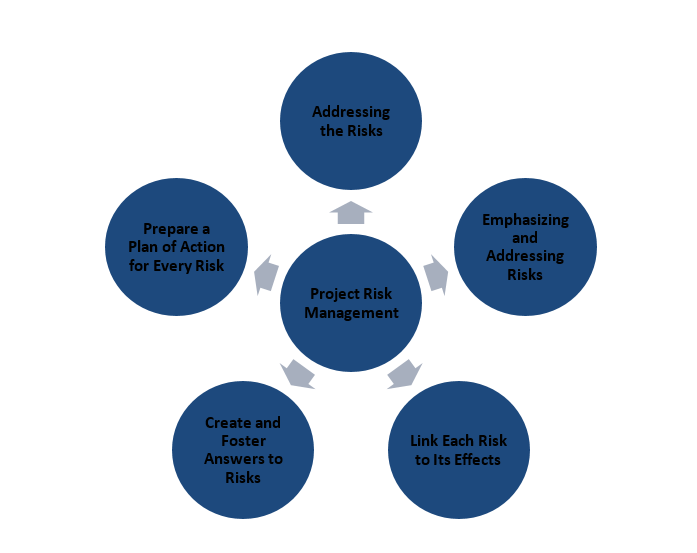
 Data Structure
Data Structure Networking
Networking RDBMS
RDBMS Operating System
Operating System Java
Java MS Excel
MS Excel iOS
iOS HTML
HTML CSS
CSS Android
Android Python
Python C Programming
C Programming C++
C++ C#
C# MongoDB
MongoDB MySQL
MySQL Javascript
Javascript PHP
PHP
- Selected Reading
- UPSC IAS Exams Notes
- Developer's Best Practices
- Questions and Answers
- Effective Resume Writing
- HR Interview Questions
- Computer Glossary
- Who is Who
Top 10 Project Risks and How to Tackle Them
Regardless of the sector of your business, it's likely that you regularly manage projects to accomplish your professional career objectives.
However, every project comes with risks. A project risk assessment tracks a project's progress from the beginning to the end in order to prevent or reduce risks or chances of failure for a business. Risks have several fundamental reasons based on a project's type, level of complexity, and duration. Locating potential risks, assessing their outcome, and formulating prevention strategies are part of the main objectives of a project risk analysis.
What are Project Risks?
A project risk implies an unforeseeable occurrence that might or might not occur throughout the course of a project.
Contrary to popular belief, a project risk can have both a positive and a negative impact on the progression of achieving the objectives of a project.
Top 10 Project Risks
There are various risks that can seriously hamper the accomplishment of a project's delivery. The top 10 most common project risks are as follows?
1. Market Risks
Market risk is probable when a project does not achieve the expected results and the situation is used by competitors to their own advantage to drive the business out of the market. Commodity and international market variations could also pose a danger to the project's early estimates. Sales of the project's products may also be hampered by liquidity, credit, as well as interest rate fluctuations.
2. Risks to Safety and Health
One form of risk that can harm a company's compliance standards is health and safety. A company's standards for health and safety should be continuously surveilled and assessed to detect any possible pitfalls that could cost financial penalties or losses. Additionally, risks can result in health issues for employees or clients, which could be detrimental to a company's image.
3. Operational Risks
A project may be interrupted or terminated if vital operations and fundamental procedures such as manufacturing or procurement are not implemented properly. Because of insufficiency or failure in quantitative, qualitative, or tactics, risks might cause an indirect or even direct loss. Based on the type of project, operational risks include?
IT system vulnerability
The direct implementation risk that involves people and processes
The indirect implementation risk posed by people and processes
Capital resource risk
4. Technological Risks
A project's technical aspects can affect data security, organizational services, compliance, and information security. Since new and cutting?edge technologies are constantly being developed, the technological aspects of a project's execution are a complicated task. Also, these risks can be more difficult to manage since installing new IT systems frequently necessitates additional human training and software procurement. Other technological hazards include service disruptions, which can cause project delays and even failure.
5. Financial Risks
A lack of efficient management of project finance due to an overestimated budget or other limitations can put the project's completion at risk. The risk may move to several other operations and manpower segments if the project cost exceeds the allocated budget. Reduced funding may also lead to the emergence of scope creep.
6. Scope Creep Risks
The cost of new features, goods, or services may increase as a result of an unplanned and unapproved modification to the project's original scope. The majority of projects experience this risk, and it can occasionally represent an irrevocable issue since some of the extra functions are critical for the successful completion of a project.
7. Project Schedule Risks or Time Constraints
The chance that ongoing tasks of your project may take longer than planned is known as a project schedule risk or time risk. Timelines that are delayed may have an effect on your delivery date, budget, or overall organizational productivity. A project manager may often encounter this risk. It's essential to estimate how long it will take your workforce to finish a project at the initial planning stage, especially when you're not handling many different working components.
8. Communication Risks
It's a great idea for you to closely adhere to the key work ethics, such as timely and efficient communication. Discussion sessions with stakeholders and project investors can allow you to track modifications, reassign duties, and develop a coordinated team. Due to the access to multiple communication devices and channels, team members can occasionally overlook the crucial components of efficient communication, resulting in data loss or misinterpretation and, ultimately, disruption to the project.
9. Risks of Poor Performance
There happen to be several instances in a project, when the expected results aren't achieved. The planned versus actual is not meeting at one point and is left far off. These performance risks have a fundamental influence on a business's overall success. Such a situation may necessitate more financing and a possible penalty for non?performance. Therefore, it can be an advantage to the performance of your competitors.
10. Risks of External Hazards
A potential risk is an unforeseeable bad occurrence that is beyond the project manager's control. These hazards might appear in many different ways, including terrorism, vandalism, natural disasters like floods, storms, earthquakes, and social upheaval. When such situations occur, a project may stagnate or fail. Businesses can avoid substantial damage or losses caused by an unexpected external threat by using suitable monitoring procedures.
5 Strategies for Dealing with Project Risks
Projects that are large?scale and technology?based have elements of uncertainty built right in. Failure or insufficient project risk management and contingency procedures can put a company in serious trouble.
Here are a few strategies to reduce project risk to keep your project operational in a timely manner.
1. Addressing the Risks
Prepare and examine a checklist of all potential hazards to the project. Conduct a range of brainstorming and planning sessions to ensure that the team members and main investors understand the goal and design of the project. Make sure the meeting's final report includes all degrees of risk.
2. Emphasizing and Addressing Risks
Since risks can have varied effects on a project, choose and implement a practical mitigation approach that will result in the greatest loss. It is important to establish a scale and rate the risks to be prepared in case of any hazardous situation. Reporting risks also assists project managers in keeping track of all activities, providing an accountability platform.
3. Link Each Risk to Its Effects
A probability matrix can aid in decision?making by assessing the possibility of risk and its consequences in order to implement timely actions. Additionally, connecting a risk to its possible impact is important since it offers the project management a detailed plan to monitor a project's actions efficiently.
4. Create and Foster Answers to Risks
You can either prevent possible risks from arising or reduce their detrimental impacts by implementing a risk response plan. Also, it is essential to examine and monitor risks on a regular basis to make sure that chances to avert a potential hazard are not overlooked.
5. Prepare a Plan of Action for Every Risk
In case any risk arises, your team needs to have a prompt and dependable plan of action that can minimize or prevent additional damage and avoid the issue from escalating. Also, consider including all stakeholders in the formulation and execution of a backup plan.
The Significance of Project Risk Analysis
The process of risk analysis is crucial since it aids in project managers' identification of a project's shortcomings, strengths, and potential prospects. There might be some significant threats that could adversely influence the successful completion of a scheduled project. Hence, it is better to acquire some knowledge about these issues to analyze risks efficiently.
To avoid or reduce losses, it is essential to make a checklist of all unforeseen circumstances that could affect the technology, resources, and processes of an ongoing project. A robust readiness plan is part of a complete preventive strategy and is necessary to manage losses efficiently.
Conclusion
One of the most crucial steps of every project is the planning phase. Although you might believe that the necessary actions are to be taken during the development stage, a robust plan to handle project risks is what you need the most as it helps your business succeed.

